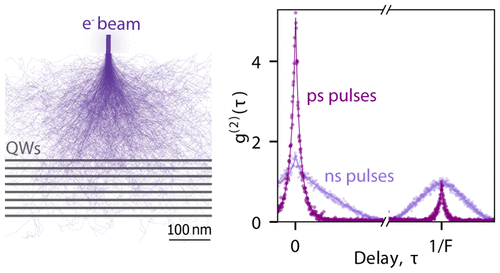当前位置:
X-MOL 学术
›
ACS Photonics
›
论文详情
Our official English website, www.x-mol.net, welcomes your feedback! (Note: you will need to create a separate account there.)
Photon Statistics of Incoherent Cathodoluminescence with Continuous and Pulsed Electron Beams
ACS Photonics ( IF 7 ) Pub Date : 2021-02-11 , DOI: 10.1021/acsphotonics.0c01939 Magdalena Solà-Garcia 1 , Kelly W. Mauser 1 , Matthias Liebtrau 1 , Toon Coenen 1, 2 , Silke Christiansen 3 , Sophie Meuret 4 , Albert Polman 1
ACS Photonics ( IF 7 ) Pub Date : 2021-02-11 , DOI: 10.1021/acsphotonics.0c01939 Magdalena Solà-Garcia 1 , Kelly W. Mauser 1 , Matthias Liebtrau 1 , Toon Coenen 1, 2 , Silke Christiansen 3 , Sophie Meuret 4 , Albert Polman 1
Affiliation

|
Photon bunching in incoherent cathodoluminescence (CL) spectroscopy originates from the fact that a single high-energy electron can generate multiple photons when interacting with a material, thus, revealing key properties of electron–matter excitation. Contrary to previous works based on Monte Carlo modeling, here we present a fully analytical model describing the amplitude and shape of the second order autocorrelation function (g(2)(τ)) for continuous and pulsed electron beams. Moreover, we extend the analysis of photon bunching to ultrashort electron pulses, in which up to 500 electrons per pulse excite the sample within a few picoseconds. We obtain a simple equation relating the bunching strength (g(2)(0)) to the electron beam current, emitter decay lifetime, pulse duration, in the case of pulsed electron beams, and electron excitation efficiency (γ), defined as the probability that an electron creates at least one interaction with the emitter. The analytical model shows good agreement with the experimental data obtained on InGaN/GaN quantum wells using continuous, ns-pulsed (using beam blanker) and ultrashort ps-pulsed (using photoemission) electron beams. We extract excitation efficiencies of 0.13 and 0.05 for 10 and 8 keV electron beams, respectively, and we observe that nonlinear effects play no compelling role, even after excitation with ultrashort and dense electron cascades in the quantum wells.
中文翻译:

连续和脉冲电子束不相干阴极发光的光子统计
非相干阴极发光(CL)光谱中的光子聚束源于以下事实:单个高能电子在与材料相互作用时会产生多个光子,从而揭示了电子物质激发的关键特性。与以前基于蒙特卡洛模型的工作相反,我们在此提供了一个完整的分析模型,该模型描述了连续和脉冲电子束的二阶自相关函数(g (2)(τ))的幅度和形状。此外,我们将光子聚集的分析扩展到超短电子脉冲,其中每个脉冲最多500个电子在几皮秒内激发样品。我们获得一个有关聚束强度(g (2)(0)表示电子束电流,发射器衰减寿命,在脉冲电子束情况下的脉冲持续时间以及电子激发效率(γ),定义为电子与发射器产生至少一种相互作用的概率。该分析模型与使用连续ns脉冲(使用电子束消隐器)和超短ps脉冲(使用光发射)电子束在InGaN / GaN量子阱上获得的实验数据显示出良好的一致性。我们分别对10和8 keV电子束提取了0.13和0.05的激发效率,并且观察到即使在量子阱中用超短和致密的电子级联激发后,非线性效应也没有令人信服的作用。
更新日期:2021-03-17
中文翻译:

连续和脉冲电子束不相干阴极发光的光子统计
非相干阴极发光(CL)光谱中的光子聚束源于以下事实:单个高能电子在与材料相互作用时会产生多个光子,从而揭示了电子物质激发的关键特性。与以前基于蒙特卡洛模型的工作相反,我们在此提供了一个完整的分析模型,该模型描述了连续和脉冲电子束的二阶自相关函数(g (2)(τ))的幅度和形状。此外,我们将光子聚集的分析扩展到超短电子脉冲,其中每个脉冲最多500个电子在几皮秒内激发样品。我们获得一个有关聚束强度(g (2)(0)表示电子束电流,发射器衰减寿命,在脉冲电子束情况下的脉冲持续时间以及电子激发效率(γ),定义为电子与发射器产生至少一种相互作用的概率。该分析模型与使用连续ns脉冲(使用电子束消隐器)和超短ps脉冲(使用光发射)电子束在InGaN / GaN量子阱上获得的实验数据显示出良好的一致性。我们分别对10和8 keV电子束提取了0.13和0.05的激发效率,并且观察到即使在量子阱中用超短和致密的电子级联激发后,非线性效应也没有令人信服的作用。


























 京公网安备 11010802027423号
京公网安备 11010802027423号